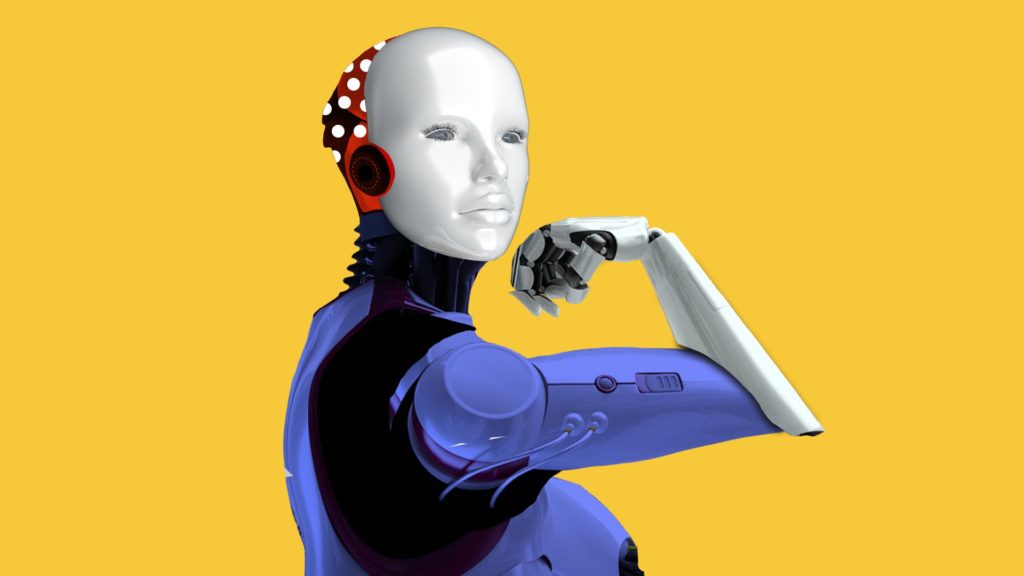
In a move toward humility, robot designers are increasingly shunning the Westworld dream of machines whose behavior is indistinguishable from people’s, and opting for greater honesty about what’s truly possible now.
Why it matters: When people assume a machine can do what a human does, they can be disappointed at best — and at worst get hurt. Visualizations, explanations and signals that show how robots are actually able to interact can better set expectations, and build the right amount of trust.
Societal acceptance is the make-or-break issue. “We don’t want to build another Google Glass that’s going to be rejected by society,” Ali Kashani, head of R&D at Postmates, a delivery company that uses sidewalk bots, tells Axios.
Autonomous vehicles are at the front lines of the tension between aping humans and highlighting a bot’s bot-ness.
- The blend-in approach would tuck away a car’s sensors and cameras and have the car emulate human driving styles. But people break driving laws regularly, which manufacturers want to avoid.
- Drive.ai, a self-driving startup, is using the opposite tack, deploying fluorescent-orange autonomous Nissan vans in the northern Dallas suburb of Frisco. They call attention to themselves and encourage drivers and pedestrians to treat them cautiously, the company’s CEO, Sameep Tandon, told Axios recently.
- Electronic panels adorn the outside of the Drive.ai vans, displaying messages like “Waiting for you” that tell pedestrians it’s safe to cross, thus replacing the absent driver’s nod or wave.
On the factory floor, it’s useful for workers to understand what the enormous, super-powerful robots next to them can and can’t see or do.
- In order to feel comfortable, a person needs a mental model of the bot’s capabilities, said Clara Vu, VP of engineering at Veo Robotics. So robots using Veo’s system come with a monitor displaying the bot’s perception of its surroundings, and its prediction of how it and the humans around it can move in the coming seconds.
- The interior of many autonomous vehicles include similar visualizations, reassuring passengers that yes, it does see the semi taking a left across the intersection.
The big picture: At the other extreme, people sometimes initially put too much trust in a car’s capabilities, said David Sirkin, an engineer and interaction-design researcher at Stanford.
- “If a car starts behaving like a person in a few ways, we’re going to start expecting it to behave like people do” all the time, Sirkin said. “Except it can’t.”
- A mismatch of expectations and reality can be dangerous. Take, for example, the proliferation of YouTube videos showing early Tesla owners doing all manner of unsafe things inside their cars. In Sirkin’s own research, test subjects have fallen asleep while monitoring a self-driving car in high-fidelity simulations.
The big picture: The aim is to push humans to trust robots more, but while recognizing their limits. Often, people initially put too much trust in a car’s capabilities, said David Sirkin, an engineer and interaction-design researcher at Stanford.
- A mismatch of expectations and reality can be dangerous. Take, for example, the proliferation of YouTube videos showing early Tesla owners doing all manner of unsafe things inside their cars. In Sirkin’s research, test subjects have fallen asleep while monitoring a self-driving car in high-fidelity simulations.
It’s one thing to get people to understand and anticipate robots on public roads, and another entirely when they occupy much more intimate sidewalks.
- We already have mental models for how cars should drive but no frame of reference for small, wheeled tubs that navigate foot traffic on their own.
- Sidewalk robots should stay out of people’s way, said Postmates’ Kashani. But since they’ll inevitably attract attention, they would benefit from interesting, cute, or surprising design touches like the expressive eyes on the Kiwi bots that trundle through Berkeley.
The big question: Can we set societal expectations for how we want robots to act before they become a part of daily life?
- “Autonomy is coming towards us. But we don’t know how well and how fast,” said Sirkin. “We might have the technology available before we have resolved the societal issues.”